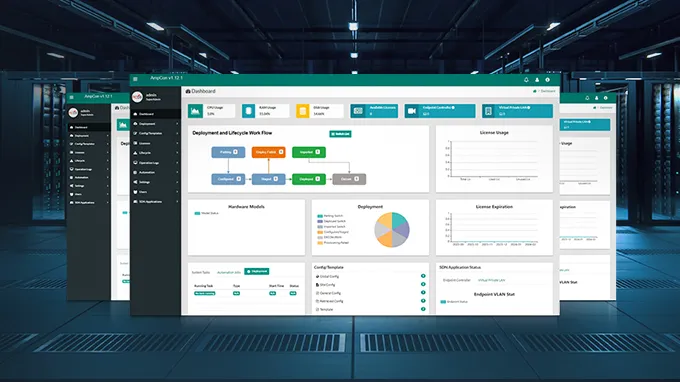How to Choose the Suitable PoE Switches for IP Camera Systems?

To obtain visibility and insight into your business, IP cameras are a vital component of most business-related surveillance systems. At the same time, IP cameras are also widely used in various home scenarios for surveillance and security purposes. PoE switches for IP cameras are quite prevalent in today's world. They simplify cabling, provide power and data over a single Ethernet cable, and offer versatile solutions for both home and business surveillance. In this post, the article will explore the factors you should consider when selecting a PoE switch, provide some purchasing tips, and empower you to make an informed choice that suits your specific needs.

Why Use the PoE Switch for IP Camera Systems?
The key advantage of the PoE switch is its ability to transport both power and data over a single line, eliminating the need for an individual power supply for each camera or a traditional power box.
-
Extended Cable Runs: The main advantage of PoE switches is that they can connect cameras over longer distances without worrying about voltage loss or cable quality. Ethernet is restricted to 328 feet. However, this range may be easily increased by connecting the PoE network switch or utilizing PoE extenders. This flexibility is especially valuable for outdoor and large-scale surveillance systems.
-
Simplified Cabling: PoE technology allows you to transmit both power and data over a single Ethernet cable. This reduces the complexity of cabling and minimizes installation costs.
-
Multiple Device Connections: PoE switches come in various port configurations, enabling you to connect multiple IP cameras and other PoE devices to a single switch.
How to Choose The Suitable PoE Switch for IP Camera Systems?
To choose a suitable, reliable and best PoE switch for your IP security cameras, there are few factors you need to consider:
- Port Speed, Port Numbers, and Power Requirements
IP cameras not only require power but also a stable network connection provided by the PoE switch. Different switches offer varying bandwidth capacities. For instance, fast-Ethernet PoE switches typically provide between 10 to 100 Mbps, while gigabit PoE network switches offer 1 Gbps. Beyond that, the number of ports your PoE switch has and their power capabilities is a fundamental consideration. Calculate the number of IP cameras you intend to connect to the switch and assess their power requirements.
- Power Supply Voltage
Ensure that the power supply voltage of the switch aligns with the voltage requirements of your IP cameras. Using the wrong power voltage can lead to camera malfunction, causing irreversible damage.
- Power Budget
A PoE switch's power budget is the maximum wattage that it can offer. The additional total wattage from connected devices should not approach or surpass the switch's maximum power budget. When selecting a switch, examine the budget per port to ensure that it is adequate to power your IP cameras.
- Managed vs. Unmanaged PoE Switches
The choice between managed and unmanaged PoE switches depends on your specific needs. Unmanaged switches are plug-and-play, requiring no configuration. These are suitable for home users and simple setups. Managed switches, on the other hand, offer advanced features like network optimization, remote control, and greater insight into network status. They are ideal for more extensive surveillance projects such as in enterprises or large facilities.

Tips for Selecting the Right PoE Switch for IP Camera Systems for Your Needs
To make an informed decision, consider the following tips:
-
Calculate the total power requirements of your IP cameras and ensure the switch's power budget can accommodate them.
-
Future-proof your system by choosing a IP switch with additional ports for possible camera expansions.
-
If you are setting up cameras in harsh environments, opt for industrial PoE switches designed to withstand extreme conditions.
-
For large-scale surveillance projects, a managed PoE network switch offers more flexibility, control, and oversight.
How to Connect IP Cameras to a PoE Switch?
Connecting IP cameras to a PoE switch might sound complex, but it's relatively straightforward. Here are the general steps involved:
-
Connect your router to the LAN port on the PoE network switch using an Ethernet cable (Cat5e or Cat6).
-
Plug the power cable into the PoE switch and connect it to a power outlet or a surge protector.
-
Connect your IP cameras to the available ports on the PoE switch using Ethernet cables.
-
Add the IP cameras to your Network Video Recorder (NVR) for viewing and recording. If remote access is required, connect your router to the internet.
Note: If you are looking for a PoE switch to be used in harsh environments such as traffic control cabinets, factory floors, and outdoor places where the temperature is extremely low or high, FS's industrial PoE switches can be a good choice.
These switches comply with IEEE 802.3af/at PoE standards and can automatically detect and provide the required power for your PoE devices. Other than that, they can also withstand a high degree of vibration and shock while operating in harsh environments from -40° to 75°C, which makes them ideal for outdoor surveillance deployment.

Summary
Choosing the right PoE switch for IP camera systems is paramount for building an efficient and reliable IP camera system. By considering factors like port numbers, power supply voltage, power budget, maximal power supply, bandwidth capacity, and managed/unmanaged switch options, you can tailor your choice to your specific needs. We also provide unmanaged/managed PoE switches with 8-port,16-port, 24-port, 48-port, and industrial switches for different IP camera security systems. For more information, check out FS PoE Switches.
Related article:
You might be interested in
Email Address

-
PoE vs PoE+ vs PoE++ Switch: How to Choose?
May 30, 2024













